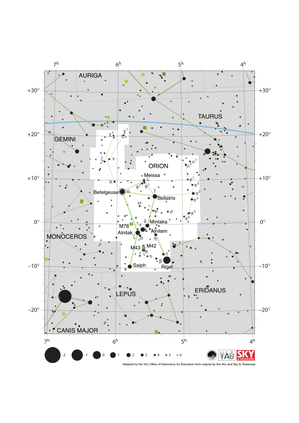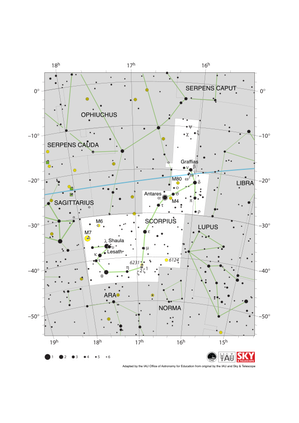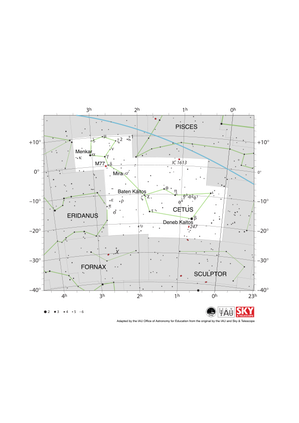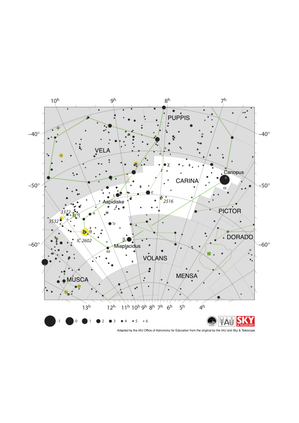Glossary term: Étoile variable
Description: Une étoile variable est une étoile dont la luminosité varie fortement au fil du temps pour les observateurs. La luminosité de toutes les étoiles change sur des millions ou des milliards d'années en raison de leur évolution stellaire. Le terme d'étoile variable est généralement réservé aux étoiles dont la luminosité varie sur des échelles de temps beaucoup plus courtes que celles de leur évolution.
Plusieurs mécanismes physiques peuvent être à l'origine de cette variabilité. Certaines étoiles, comme les variables céphéides ou les étoiles RR Lyrae, sont instables et pulsent, changeant ainsi de taille et de luminosité.
D'autres étoiles peuvent éjecter de la matière brillante qui augmente la luminosité globale observée ("variables éruptives"). Les étoiles appelées variables cataclysmiques ou novae présentent une augmentation soudaine de leur luminosité suivie d'un retour à leur niveau antérieur. Dans ces systèmes, le scénario est celui d'une paire d'étoiles, la matière de l'une s'écoulant sur l'autre et s'enflammant dans une réaction de fusion nucléaire dès qu'un certain seuil est atteint. L'un ou l'autre des compagnons subit l'explosion cataclysmique et l'augmentation d'éclat.
D'autres étoiles semblent variables parce qu'elles tournent, nous montrant alternativement un côté plus brillant et un côté moins brillant, ou parce qu'il s'agit en réalité de deux étoiles en orbite l'une autour de l'autre, l'une d'entre elles étant périodiquement éclipsée par son compagnon. Cette dernière catégorie de binaire est connue sous le nom de binaire à éclipses.
Related Terms:
- Variable céphéide
- Nova
- Fusion nucléaire
- Evolution stellaire
- Tache solaire
- Supernova
- Naine blanche
- Accrétion
See this term in other languages
Term and definition status: The original definition of this term in English have been approved by a research astronomer and a teacher The translation of this term and its definition is still awaiting approval
The OAE Multilingual Glossary is a project of the IAU Office of Astronomy for Education (OAE) in collaboration with the IAU Office of Astronomy Outreach (OAO). The terms and definitions were chosen, written and reviewed by a collective effort from the OAE, the OAE Centers and Nodes, the OAE National Astronomy Education Coordinators (NAECs) and other volunteers. You can find a full list of credits here. All glossary terms and their definitions are released under a Creative Commons CC BY-4.0 license and should be credited to "IAU OAE".
If you notice a factual or translation error in this glossary term or definition then please get in touch.
Related Diagrams
Orion Constellation Map
Credit: Adapted by the IAU Office of Astronomy for Education from the original by IAU/Sky & Telescope
License: CC-BY-4.0 Creative Commons Attribution 4.0 International (CC BY 4.0) icons
Scorpius Constellation Map
Credit: Adapted by the IAU Office of Astronomy for Education from the original by IAU/Sky & Telescope
License: CC-BY-4.0 Creative Commons Attribution 4.0 International (CC BY 4.0) icons
Cetus Constellation Map
Credit: Adapted by the IAU Office of Astronomy for Education from the original by IAU/Sky & Telescope
License: CC-BY-4.0 Creative Commons Attribution 4.0 International (CC BY 4.0) icons
Carina Constellation Map
Credit: Adapted by the IAU Office of Astronomy for Education from the original by the IAU and Sky & Telescope
License: CC-BY-4.0 Creative Commons Attribution 4.0 International (CC BY 4.0) icons
Perseus Constellation Map
Credit: Adapted by the IAU Office of Astronomy for Education from the original by the IAU and Sky & Telescope
License: CC-BY-4.0 Creative Commons Attribution 4.0 International (CC BY 4.0) icons













